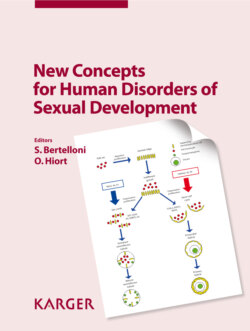Читать книгу New Concepts for Human Disorders of Sexual Development - Группа авторов - Страница 14
На сайте Литреса книга снята с продажи.
Description of Cases in Registry
ОглавлениеAt last review (February 2010), there were 548 cases on the register with a variable number of cases from a variety of clinical centres in Europe which are participating in the EuroDSD research programme (fig. 3). The median year of birth of these cases was 1993 (range, 1927-2009) and the age of presentation ranged from less than 1 month to 62 years. Sex assigned was female in 371 (68%) cases and male in the remaining 177 (32%). Out of the 371 cas-es, consent from clinical centre was available to access metadata in 307 cases. Out of these 307 female cases, 229 were 46XY, 58 were 46XX, 8 were 45X/46XY, 2 cases were of complex rearrangements of sex chromosomes and one case was a trisomy of an autosome. Out of the 177 male cases, consent from clinical centre was available to access metadata in 143 cases. Out of these 143 cases, 110 were 46XY, 19 were 45X/46XY, 8 were 46XX and there were 4 cases of another sex chromosome abnormality. The median external masculinisation score (EMS) [Ahmed et al., 2000b] at the first presentation of the cases of 46XY raised as boys and girls was 5.5 (1, 12) and 4 (0, 11), respectively (p < 0.0001, Mann Whitney U test). The median EMS at first presentation of the cases of 45X/46XY raised as boys and girls was 5 (2.5, 12) and 4 (0, 10) (NS), respectively.
Fig. 4. Associated malformations in cases in registry (February 2010).
Amongst the diagnostic criteria based on the revised DSD nomenclature, ‘disorders of androgen action’ is the commonest disorder type with 186 (34%) cases (table 1). Of these cases, 144 (77%) have been diagnosed as complete androgen insensitivity syndrome, 40 (22%) as partial androgen insensitivity syndrome and 2 (1%) cases have a diagnosis of ‘other’. The next most common category is ‘disorders of gonadal development’ with 137 (25%) cases. Amongst the 548 cases in the registry, a family history of infertility, DSD and parental consanguinity was reported in 45 (8%) cases, 130 (24%) cases and 37 (7%) cases, respectively. In 383 (70%) cases, DNA analysis had already been performed and a DNA abnormality had been detected in 248 (65%) of these 383 cases. Associated malformations are present in 121 (22%) cases, and multiple associated malformations have been reported in a number of cases (fig. 4). Out of the total cohort of 548 cases, a stored sample of DNA was available in 430 cases consented for use within the EuroDSD research programme.
The registry has the ability to perform finer grained search of cases by combining the above fields including search for genetic screens and mutations found, however, this is beyond the scope of this paper.
